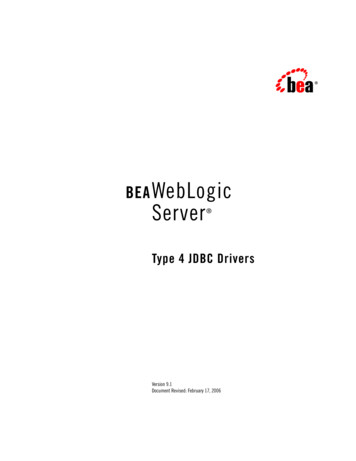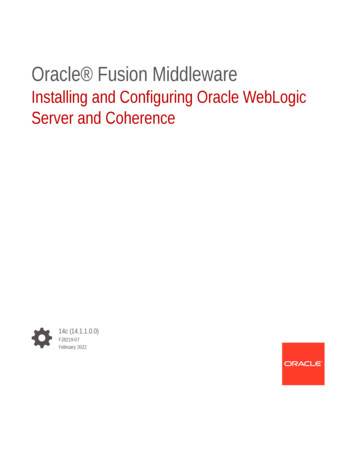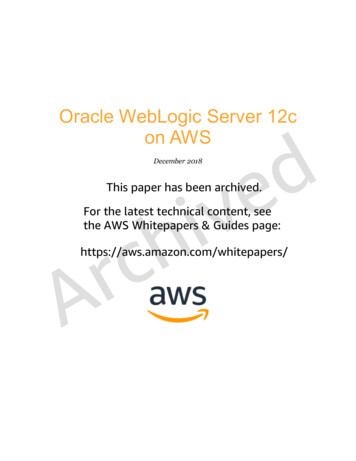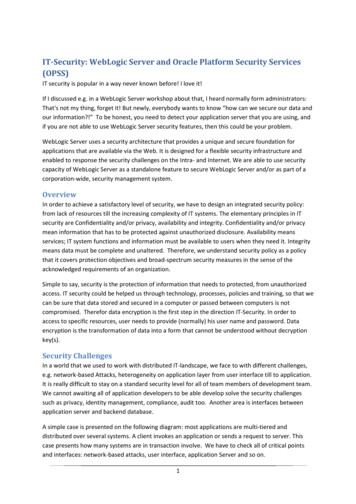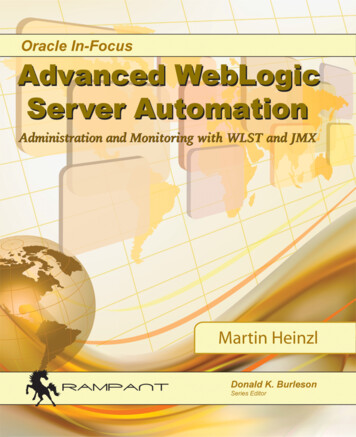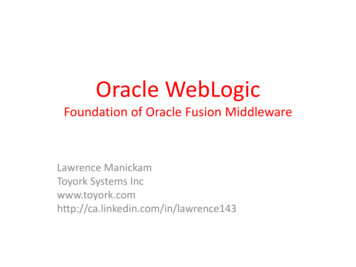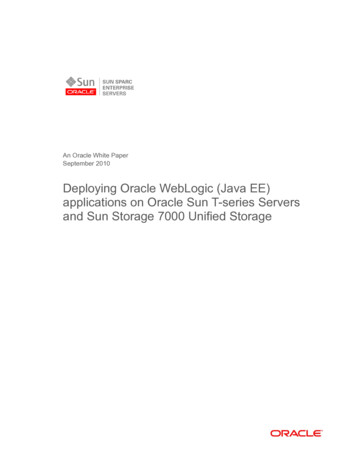
Transcription
An Oracle White PaperSeptember 2010Deploying Oracle WebLogic (Java EE)applications on Oracle Sun T-series Serversand Sun Storage 7000 Unified Storage
Deploying Oracle WebLogic (Java EE) applications on Oracle Sun T-series Servers and Sun Storage 7000 Unified StorageIntroduction. 4Reference Architecture . 6Major Components. 6Architecture overview . 10Benefits . 16Summary. 20Variations . 21Separate T-series Database Server . 21Oracle Real Application Cluster (RAC) . 22WebLogic Clustering . 23Other Reliability Variations . 23Setup Guide. 24System installation and setup . 24Software installation . 35References . 41Appendix A – Creating and Installing a Zone . 42Appendix B – Creating an iSCSI target and ZFS pool. . 44
Deploying Oracle WebLogic (Java EE) applications on Oracle Sun T-series Servers and Sun Storage 7000 Unified StorageIntroductionJava Enterprise Edition (Java EE) applications have become the standard for developing anddeploying enterprise web applications. Oracle provides hardware and software that is designed towork together, and gives many benefits to do so: Full platform – All components from the application server to the database, the hardwarethey run on, are part of the Oracle platform: no third party software is needed to deploy yourJava EE applications. Tested together – Having the Oracle database and Oracle WebLogic server tested byOracle engineers on Oracle server hardware and storage hardware ensures a more robustplatform than when such testing is done by third parties. Supported together – The support for all the components: hardware and software includingvisualization and operating system is from one vendor with a single point of contact. Fully certified – All of the infrastructure components into which your Java EE application isbeing deployed have been certified by Oracle engineers.With these benefits and others in mind this paper documents a reference architecture for deployingOracle WebLogic Server / Java EE applications onto Oracle Sun T-series servers and storage.Specifically this document provides an example of consolidating multiple Java EE applications andworkloads onto a single Sun SPARC T-series server with Sun Storage. In this architecture theWebLogic 11g application server and Oracle 11gR2 database tiers are combined onto a single serverby utilizing Oracle virtualization technologies. Additionally, this paper presents some alternatives tothe described architecture to allow the reader to explore other, more complex options such as greateravailability via clustering.
Deploying Oracle WebLogic (Java EE) applications on Oracle Sun T-series Servers and Sun Storage 7000 Unified StorageHow this document is organizedThis paper is divided into three sections, the first describes the reference architecture and the seconddescribes possible variations of this architecture. The third section is specifically designed for JavaEE application deployers and system administrators to assist in the system configuration anddeployment of their Java EE applications.ScopeThis paper is a reference architecture, detailing systems Oracle engineers have built and tested andare typical of Oracle customer deployments. This paper is not, however, a “best practices guide”.Full system tuning and performance recommendations are beyond the scope of this document.References are supplied for more information that may assist the reader in these areas.AudienceThis document is intended to be read by systems administrators, Java EE application developers anddeployers and to anyone interested in modern virtualized systems architectures. Additionally it maybe of interest to those wanting to know more about the various Oracle software and hardwarecomponents and advantages in delivering a consolidated topology from a single vendor.It assumes the reader is familiar with Java EE concepts, a general understanding of computersystems hardware and the command line, and some familiarity with a UNIX or Linux-likeenvironment.
Deploying Oracle WebLogic (Java EE) applications on Oracle Sun T-series Servers and Sun Storage 7000 Unified StorageReference ArchitectureMajor ComponentsThe reference architecture presented in this paper has many components integrated together fromhardware to software, and from applications to workloads. This chapter provides a summary anddetails about each of these.The following is a summary of components that was used to test the reference architecture. Thearchitecture is generally applicable to all T-series servers and Storage 7000 Unified Storage Systems: Server: Sun SPARC Enterprise T5240 Server Storage: Sun Storage 7410 Unified Storage System Operating system: Oracle Solaris 10 Operating System Virtualization: Oracle VM Server for SPARC v1.3 Oracle Solaris Containers Database: Oracle Database 11 g Release 2 Java EE Application Server: Oracle WebLogic Server Release 1 Java: Sun JDK version 6.0 Applications/Workloads: MedRec sample Java EE application SPECjEnterprise2010 benchmarkNote: The number of Java EE applications that can be deployed onto a single Sun SPARC T-series server isdetermined by the resource requirements of the applications and the utilization (number of users of theapplication). This architecture demonstrates the principles of deploying multiple applications but the sizing ofthese applications is beyond the scope of this document.Detailed Component DescriptionServerThe Sun SPARC Enterprise T5240 Server is a two socket, eight core per socket server using theUltraSPARC T2 Plus processor with chip multithreading technology. The server has eight hardwarethreads per core and between the two processors provides a total of 128 hardware threads available forvirtualization. The server is equipped with 64 GB memory and can be configured with up to 256 GB
Deploying Oracle WebLogic (Java EE) applications on Oracle Sun T-series Servers and Sun Storage 7000 Unified Storagememory and a maximum of 16 internal disk drives. The T5240 features a b uilt-in hypervisor (on chip)for virtualization and is SPARC binary compatible.StorageThe Sun Storage S7410 Unified Storage System is a high capacity storage device with high throughputfeatures and a simple to use management interface that makes it ideal for storage requirements ofconsolidated Java EE applications. Major features include: Use of flash memory to speed data reads and writes Predictive Self-Healing and diagnosis of all system hardware failures ZetaByte File System (ZFS) end-to-end data checksums of all data and metadata, protecting datathroughout the stack RAID-6 (Double Parity) and optional RAID-6 across disk shelves Active-active clustering for high availability (7310 and 7410) Link aggregations and IP multi-pathing for network failure protection I/O multi-pathing between the controller and disk shelves Integrated software restart of all storage system software services
Deploying Oracle WebLogic (Java EE) applications on Oracle Sun T-series Servers and Sun Storage 7000 Unified StorageOperating SystemThe Oracle Solaris 10 Operating System is an enterprise-grade operating system, and is used for all SunT-series and M-Series servers, as well as being available on x86-based servers from Oracle. OracleSolaris Containers (see below) and Oracle Solaris ZFS are used in this architecture to securely andconveniently host and deploy Java EE applications. Some of the major features include: 64-bit operating environment High performance Support for large memory and high CPU count systems Excellent scalability for richly threaded environments Advanced filesystem Predictive, self-healing features Built-in virtualization Extensive instrumentation and diagnostic capabilities to assist performance and availabilityVirtualizationThe virtualization technologies of Oracle VM Server for SPARC and Oracle Solaris Containers areincluded as part of the Oracle T-series servers and Solaris operating system respectively. They bothallow the rapid deployment of virtual environments, resource controls and efficient use of sharedresources, but also offer distinct differences allowing them to be used in a wide variety of situations.Oracle VM Server for SPARC (formerly known as Sun Logical Domains) provides full hardwarebased hypervisor virtualization capabilities for SPARC, allowing up to 128 virtual machines to becreated. OVM server for SPARC enables reliable consolidation and deployment of applications byproviding secure isolation between running instances of the Solaris operating system.Oracle Solaris Containers (also known as zones) are an included feature of the Oracle Solaris 10operating system (on both SPARC & x86 platforms) and allows kernel-level separation of applicationsrunning in a single Oracle Solaris 10 instance. Oracle Solaris Containers are rapid to deploy, offer lowoverhead and are used in this reference architecture to separate instances of Oracle WebLogic Serverwithin a single virtual machine which are both running the SPECjEnterprise2010 benchmarkapplication.DatabaseTPC-C benchmarks provide a good illustration of the performance benefits of running Oracle database on Oraclehardware . For details The Oracle Database 11g Release 2 Database is a full featured enterprise class relational databasewhich this reference architecture uses as the persistence tier of the Java EE applications.
Deploying Oracle WebLogic (Java EE) applications on Oracle Sun T-series Servers and Sun Storage 7000 Unified StorageJava EE Application ServerThe Oracle WebLogic Server 11g Release 1 is a fully compliant Java EE 5.0 application server which isfeature rich and holds benchmark world records for Java EE performance. Oracle WebLogic Server11g takes full advantage of the 64-bit addressable memory and also the large number of hardwarethreads available in Sun SPARC T-series servers such as the Sun SPARC T5240 used in thisarchitecture.Java Standard Edition 6.0Java Standard Edition 6 (Java SE 6) is the current shipping edition of the Java SE platform runtimeand code development kit. Java SE 6 provides the platform on which the Oracle WebLogic Server11g executes. For more information on Java SE 6 refer to the comprehensive resources available on theOracle technical network at Java EE ApplicationsThis architecture uses two applications to demonstrate various deployment methodologies:Note: the name Java Enterprise Edition (Java EE) encompasses the current Java EE 5.0 version and the previousversion which was formerly Java 2 Enterprise Edition (J2EE)Avitek Medical Records (or MedRec) is designed as an educational tool for Java EE developers; itshowcases the use of Java EE components, and illustrates design patterns for component interactionand client development, and is included in the WebLogic peripheral downloads as an examplearchitecture that highlights the features of the WebLogic Server. The application demonstrates aframework for patients, doctors, and administrators to manage patient data using a variety of differentclients. The mock patient data includes: Patient profile information—A patient's name, address, social security number, and logininformation. Patient medical records—Details about a patient's visit with a physician such as the patient'svital signs and symptoms as well as the physician's diagnosis and prescriptions.SPECjEnterprise2010 is a benchmark workload which involves many aspects of a system and wascreated by SPEC as a standard Java EE benchmark. In this reference architecture, theSPECjEnterprise2010 application is not used as a benchmark but as a good example of a complex andresource intensive application typical of enterprise businesses that run and rely on Java EE andWebLogic for their core business functions.
Deploying Oracle WebLogic (Java EE) applications on Oracle Sun T-series Servers and Sun Storage 7000 Unified StorageArchitecture overviewThis section describes the physical and virtual architecture of the system and the software deployment.Physical architectureThe physical architecture of the system is simple, the SPARC T-series server and the Sun Storage 7000Unified Storage System are attached to the network switch using the four on-board 1 Gigabit ethernetinterfaces that are a standard part of the server and storage systems. Other connection options areavailable such as fibre channel and these can be used instead of, or in conjunction with the ethernetconnections. This architecture uses and assumes the simple network connection shown Figure 1.Figure 10. Connections.
Deploying Oracle WebLogic (Java EE) applications on Oracle Sun T-series Servers and Sun Storage 7000 Unified StorageVirtual EnvironmentTip for larger and more complex deployments, the naming scheme becomes important so as to enable easyidentification of virtual machine/container and it's associated function.Using Oracle VM Server for SPARC, the SPARC Enterprise T5240 is logically divided into four guestdomains and one administration domain as shown below. The domain names highlight the purpose ofthe domain. The first part of the name refers to “logical domain” or “ld” for short. The second partof the domain name refers to application server (“as” for short) or database server (“db” for short).In the ld03-as02 domain, there 2 Oracle Solaris containers (a.k.a zones) which are used to supportinstances of the WebLogic Server. The reason for the use of both logical domains and Solaris zoneswill be discussed in a later section.Figure 1: Virtual Architecture
Deploying Oracle WebLogic (Java EE) applications on Oracle Sun T-series Servers and Sun Storage 7000 Unified StorageFor a full introduction to Oracle VM server for SPARC see the “Beginners Guide to Ldoms”Hardware threads are a feature of the Oracle Sun T-series servers and can be thought of as a virtual cpu (vcpu)In this reference architecture the “primary” domain serves as the I/O domain and the Service Domain.The domains created by Oracle VM Server for SPARC have dedicated access to their CPU andmemory (not shared) and have certain “roles”. These determine the hardware components availabledirectly to them, and the functions and features each domain can deliver and subscribe to. Thefollowing is an overview of the various roles, which are NOT custom to the sample applications, butrather exist as the way OVM Server for SPARC separates out the server’s resources: Control Domain – This default domain is created when the operating system is installedonto the T-series hardware. The Control Domain communicates with the hypervisor to makechanges to configuration, and is the domain where access to the logical domains commandline (ldm) is accessed. There can be only one of these domains per-system, and is referred toas “primary”. I/O Domain - This domain has physical access to I/O devices such as network and disk.By default the control domain “owns” all physical I/O devices but an then share these devicesout to other domains in various ways depending upon the hardware platform. Multiple I/Odomains can be created, although only one was used in the tested architecture. Service Domain – This domain provides virtualized services based upon physical devicessuch as virtual disk services and virtual network switches. These devices are essentiallypublished to other domains which can connect to them with the service domain acting as a“proxy”.It is also possible to create services that do not have a hardware component, such as in the case of an internalvirtual switch service to route between two domains without an external interface. This is called a “routed-mode”virtual switch. Guest Domain(s) – These domains have no access to physical devices. In Figure 1, ld01as01, ld02-db01, ld02,as02, ld04-db02 are guest domains. They subscribe to virtual servicessuch as vdisk server and virtual switches with virtual devices such as vdisk and vnet.
Deploying Oracle WebLogic (Java EE) applications on Oracle Sun T-series Servers and Sun Storage 7000 Unified StorageResource AllocationsNote: A feature of this architecture is that resource assignment is extremely flexible, vcpu, memory and virtualnetwork adapters can be easily re-assigned to the busiest guest domains and vcpus can be allocated dynamically,perhaps switched during times of peak load for an application.The diagram below shows the initial resource allocation of the SPARC server. Note the primarydomain requires adequate cpu and memory resources as the act of enforcing the various services andI/O falls to the Control Domain.Figure 2: resource allocationsNote: Resources such as memory and VCPU are not shared between domains (often referred to as oversubscription in other virtual environments). In Oracle VM for SPARC resources are assigned to domainsexclusively, and this assignment persists across reboots.From the primary domain and logged in as the root user the Virtual Machines (LDoms) and resourceallocations can be listed.Note: Oracle VM server for SPARC was formerly known as Sun Logical Domain Manager and some terminology isstill embedded in the technology , thus an LDom or domain is a virtual machine.# ldm SSPVCPU8MEMORY4G5.8%22d 10h 31mld01-db01active-n----5000307G0.2%14d 3h 21mld02-as01active-n----5001307G0.0%14d 7h 42mld03-db02active-n----5002307G0.1%11d 22h 31mld04-as02active-n----5003307G0.0%22d 2h 10m
Deploying Oracle WebLogic (Java EE) applications on Oracle Sun T-series Servers and Sun Storage 7000 Unified StorageNetworking ArchitectureThe architecture uses an Oracle VM feature that allows for “routed mode” virtual switches (vsw) to becreated for all network traffic between application server and database. These virtual switches requireno physical network adapter nor cabling and can be created dynamically, therefore routing theirnetwork traffic completely inside of the server itself, eliminating the need for external networkingports. See the “Setup Guide” section for details.Figure 3: virtual network configurationFor external network access, virtual switches are created using a physical device e.g. the gigabit ethernetnxge0 interface and then the virtual networks are created using the virtual switch and plumbed in thenormal fashion. Because no Solaris domain has direct access to the hardware, this virtualization layerneeds to be created, even if the specified Solaris domain has sole access to the networking hardware.Networks established Primary domain - uses the nxge adapter to allow users to connect and administer the server. Application Server Virtual Machines – one routed mode (internal network connection) vswto the database and one nxge hosted vsw to the user network to allow for incoming requests. Database Server Virtual Machines – one routed mode vsw to the application server, one nxgehosted vsw to the storage and one nxge hosted vsw for administrator access.
Deploying Oracle WebLogic (Java EE) applications on Oracle Sun T-series Servers and Sun Storage 7000 Unified StorageNote that in this architecture using routed mode switches means that the network ports for the database need noteven be available on the company intranet, this enhances the security of the database and corporate data.Previously this level of database isolation would require expensive switches and complicated VLANconfigurations.Virtual Machine ImagesNote: See Appendix B for an example of how to create the virtual machine images on the Sun Storage S7410.To establish the architecture a template virtual machine or golden LDom image with a vanilla Solarisinstallation is established on a ZFS zvol on the Sun Storage S7410. The advantage of this approach isthat the ZFS “snapshot” and “clone” features can be utilized to instantly create the Solarisinstallations on the four guest virtual machines. The need to install the operating system more thanonce is eliminated. This approach can also be used to update the operating system and softwareinstallation of the virtual machines in the future. Whilst the internal disks of the server could be usedto host the root filesystems the use of the Sun Storage S7410 to host the virtual operating systeminstalls offers two significant advantages. Firstly the Sun S7410 provides a large amount of storage,ensuring that the “/” filesystem is unlikely to “fill up” in any of the guest virtual machines andsecondly the images are highly available due to the use of the reliability features of the Sun StorageS7410 i.e. zfs raid-z is used for these root volumes.Software ArchitectureEach application (MedRec and SPECjEnterprise2010) is installed into separate sets of WebLogicservers and Oracle database server instances.The Oracle database and the Oracle WebLogic server that host each of the user applications areinstalled into separate virtual machines. This keeps the applications, the data and the user base for eachserver and for each function isolated from each other and from other applications running on the samephysical hardware.In many Java EE applications there will be a need to run more than one instance of the WebLogicapplication server. In this architecture it is assumed that SPECjEnterprise2010 application will requiremore than one instance of the WebLogic server. Given the low resource overhead and the ease of usecharacteristics of Oracle Solaris Containers (zones) it is both efficient and convenient to separate thesemultiple application servers instance by installing them into different zones. This architecture takesadvantage of the clone feature of Solaris 10 and zone 2 is created by “cloning” zone 1 which has aninstalled WebLogic instance and deployed SPECjEnterprise application.Networking and communication between application server virtual machines and database virtualmachines is provided via OVM for SPARC virtual switches. Use of these virtual switches mean thatthe application server to database traffic is kept on the backplane of the Sun SPARC T5240 server andnever goes over a network cable. This is both efficient and secure.
Deploying Oracle WebLogic (Java EE) applications on Oracle Sun T-series Servers and Sun Storage 7000 Unified StorageBenefitsThe architecture presented offers a number of significant advantages to users wishing to deploy JavaEE applications, especially when compared to deploying each Java EE application and database on aseparate server. These include: Flexible resource allocation for Java EE applications Security Scalability Reliability and availability of Java EE application data Power and space savings Benefits from a single vendor solution Certification, testing and inclusion (i.e. cost savings)Flexible Resource AllocationNote: With Oracle VM server for SPARC V1.3, a restart of the server is required for changing memory; however it isanticipated that in future releases memory will be dynamically allocated in a similar fashion to cpu resources.The Oracle VM Server for SPARC allows reassignment of compute resources (vcpu's) dynamically e.g.to move a virtual cpu (VCPU) from the first database instance to the second use the ldm command#ldm remove-vcpu 1 ld01-db01#ldm add-vcpu1 ld03-db02In a similar fashion memory can be moved between virtual machines, new networks can be created ordestroyed and or storage links established. The key benefit is that because the virtual machineboundaries are flexible, deployers and system administrators can re-allocate resources at any time or forany reason. For example, if there is a cpu-intensive batch application that needs to run every night, thevcpus can be re-assigned to the domain in which that application is deployed.Note: Oracle VM Server for SPARC also allows CPU resources to be reassigned based on a policy, for instanceextra cpu resources could be allocated to the database virtual machines in the evenings for “reporting or batchwork” or other database administration tasks.SecurityThis reference architecture is a secure platform for deployment of Java EE applications. This is due toboth the underlying security of the Oracle Solaris 10 operating system and the implementation of theOracle VM Server for SPARC in conjunction with Oracle Solaris 10.
Deploying Oracle WebLogic (Java EE) applications on Oracle Sun T-series Servers and Sun Storage 7000 Unified StorageSolaris 10 securitySecurity is a fundamental part of the design of the Oracle Solaris 10 Operating System, as such theinstallation defaults are such that attack surface is minimized, in addition to offering robust securityfeatures in the operating system itself. Important security features that are part of the architecture orcan be applied to the architecture include: Auditing and File Integrity – allows identification of access and changes in the fileinformation on the system. User and Rights Management – allows the minimum privileges to be assigned to users andsystems administrators hence minimizes the use of the super user privilege. Network Service Protection – reduces attack footprint of Solaris systems by setting sensibleand restricted network services defaults. The Solaris Security Toolkit is available and provides security for devices critical to themanagement of your server, including the control domain in the Logical Domains Manager.Other available functions are:- Hardening, Minimizing, Authorization, Auditing andcompliance.Oracle VM Server for SPARC SecurityThe Oracle VM server for SPARC hypervisor implements secure separation for each guest virtualmachine and this means that: Each guest virtual machine is unaware of other guest virtual machines. Guest virtual machines can't access the cpus or memory from other virtual machines andthere is no programing interface to allow this. Guest virtual machines can't see nor access traffic on virtual switches of other guest machines,unless configured to do so from the control domain. Guest virtual machines can't see virtual disks outside of those which they have beenspecifically assigned. Guest virtual machines do not have an interface to access the control domain.Other Security AdvantagesAccess to the console of the guest virtual machines is only via the control domain and the controldomain itself is secured by Solaris 10, this limits again limits the attack surface of the guest virtualmachines.
Deploying Oracle WebLogic (Java EE) applications on Oracle Sun T-series Servers and Sun Storage 7000 Unified StorageAvailability/ReliabilityThis architecture provides a high level of Java EE data and application availability due to the overallquality of the hardware and software components. Some features that add to this level of availabilityare listed below:Note: See the section titled “variations” for the many other features of the Oracle products that could be used tofurther increase application and data availability. The database is stored on the Sun Storage S7410 Unified Storage System which uses ZFS andenhanced error detection and self-healing. This minimizes errors and database downtime as aresult of disk failure. All of the database volumes configured in the Sun Storage S7410 for the database are utilizingZFS raid-z which is capable of dealing with 1 or 2 simultaneous device failures. TheWebLogic Server transaction logs are similarly provisioned and robust. The virtual machine boot-devices are provisioned using ZFS and raid-z so the operatingsystem image is protected from a single disk failure.Tuning Resources AvailableThe architecture features two Java EE applications running on Oracle WebLogic Server and theperformance and throughput of the Oracle WebLogic Server running on Sun SPARC T-serieshardware is demonstrated by benchmark results for the Industry Standard J2EE and Java EE 5.0SPECjAppServer2004 and SPECjEnterprise2010 benchmarks respectively. Refer tohttp://www.spec.org/jAppServer2004 or http://www.spec.org/jEnterprise2010 for more details andresults and importantly resources. For example the Oracle T-Series result 10q2/jAppServer2004-20100518-00142.htmlcontains a wealth of tuning and configuration information e.g. the Java tunings listed below are in the“full disclosure report” of the benchmark. These tunings along with the the Solaris, network, storage,WebLogic 11g and other system tunings form a valuable resource that can be drawn from for Java EEapplications running in WebLogic 11g on Sun SPARC T-series servers.JVM Options:-server -Xms3300m -Xmx3300m -Xmn1024m -Xss128k -XX: AggressiveOpts -XX: UseParallelGC-XX:ParallelGCThreads 32 -XX:PermSize 128m-XX:LargePageSizeInBytes 4m -XX: UseParallelOldGC-verbose:gc -XX: PrintGCDetails -XX: PrintGCTimeStamp-XX:-UseAdaptiveSizePolicy -XX: PrintAdaptiveSizePolicy-XX:MaxTenuringThreshold 15 -XX:InitialSurvivorRatio 10-XX:Survivo
threads available in Sun SPARC T-series servers such as the Sun SPARC T5240 used in this architecture. Java Standard Edition 6.0 Java Standard Edition 6 (Java SE 6) is the current shipping edition of the Java SE platform runtime and code development kit. Java SE 6 provides the platform on which the Oracle WebLogic Server 11g executes.
